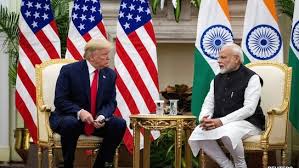India Revises Nuclear Liability Laws to Attract Global Investments
Current Affairs International IssuesPosted by newadmin on 2025-02-12 08:58:13 |
Share: Facebook | Twitter | Whatsapp | Linkedin Visits: 99

The Government of India has announced amendments to the Civil Liability for Nuclear Damage Act (CLNDA) of 2010 and the Atomic Energy Act of 1962. This decision comes ahead of Prime Minister Narendra Modi’s visits to Paris and Washington, with the primary objective of facilitating foreign nuclear investments. For over 15 years, companies from the United States and France have faced legal challenges in entering India’s nuclear sector, and these amendments seek to remove those barriers.
The move signals a departure from the government’s stance in 2015 and aims to revive long-stalled nuclear projects. Among these is the agreement with Electricite de France (EDF) to construct six nuclear reactors in Jaitapur, along with Westinghouse Electric Company’s (WEC) plans to set up six reactors in Kovvada. The amendments also align with India’s broader nuclear energy strategy, which now includes a greater emphasis on integrating advanced technologies such as small modular reactors (SMRs).
Western nuclear companies had long opposed India's stringent liability clauses in the CLNDA, arguing that they contradict the International Convention on Supplementary Compensation (CSC). These clauses were introduced in 2012 due to heightened concerns following major nuclear disasters, including the Bhopal Gas Tragedy of 1984 and the Fukushima Disaster of 2011. Under the CLNDA framework, victims of nuclear accidents are assured compensation, with a clear designation of responsibility for damages. The Vienna Convention on Civil Liability for Nuclear Damage and the CSC set global standards in this regard, ensuring a minimum compensation amount for nuclear accidents. India ratified the CSC in 2016.
The Indian law places strict liability on nuclear plant operators, requiring them to pay compensation regardless of fault. The compensation limit for operators is capped at ₹1,500 crore, which must be secured through insurance or other financial guarantees. In cases where claims exceed this limit, the Indian government assumes financial responsibility, with its liability capped at 300 million Special Drawing Rights (SDRs).
A key point of contention in the CLNDA is the supplier liability clause, which diverges from international norms. Unlike the CSC, India's legislation allows nuclear plant operators to seek compensation from equipment suppliers if an accident results from defective components or substandard services. Additionally, if supplier employees are found responsible for an incident, they can also be held accountable. This provision was introduced in response to past industrial disasters, such as the Bhopal Gas Tragedy, to ensure that suppliers bear some financial responsibility for negligence.
However, this supplier liability clause remains highly controversial. Both foreign and domestic suppliers have expressed concerns over the financial risks associated with liability, which has deterred investments in India’s nuclear sector. The lack of clear insurance guidelines has further contributed to uncertainty, with suppliers unsure about the extent of their financial exposure. There is also concern that other Indian laws could allow liability claims beyond the CLNDA framework, including the possibility of criminal prosecution.
Beyond supplier liability, other issues persist in India’s nuclear liability law. Fixed compensation limits may be insufficient in the event of a large-scale nuclear disaster. Given that most nuclear plants in India are state-owned and operated by the Nuclear Power Corporation of India Limited (NPCIL), taxpayers ultimately bear the financial burden. Additionally, the law does not include provisions for covering the clean-up costs of a nuclear accident, despite historical evidence from Chernobyl and Fukushima demonstrating the necessity of such measures. Another limitation is the absence of foreign legal jurisdiction, which means that Indian victims cannot seek compensation from international suppliers in their home countries.
The latest amendments represent a reversal of India’s 2015 policy, when the government refused to alter the CLNDA despite announcing a nuclear deal breakthrough with the United States during President Barack Obama’s visit. At that time, India attempted to mitigate supplier concerns by establishing a ₹1,500 crore insurance pool to shield them from financial risk. However, this initiative failed to attract the anticipated foreign investments.
Currently, India’s nuclear power capacity stands at 6,780 MW, with 22 operational reactors. Russia’s Rosatom is the only foreign entity actively involved in India’s nuclear sector. Looking ahead, the government has set an ambitious target of generating at least 100 GW of nuclear energy by 2047. To achieve this, it plans to invest ₹20,000 crore in the development of five small modular reactors by 2033. The proposed amendments to the CLNDA are expected to play a crucial role in enabling this expansion, making India a more attractive destination for global nuclear investments.
Search
Categories
Recent News
- Bihar's Top Cop Opens Doors to Public Grievances
- Hyderabad Gears Up for Presidential Visit: Traffic Diversions Announced
- Hyderabad Expressway Gridlock: Three-Car Pile-Up Causes Chaos
- Hyderabad Gears Up: Security Measures for Presidential Visit
- Hyderabad's Rs 23 Lakh Scam: Fake Trading App Dupes Investors
- Pinkathon Hyderabad: Empowering Women, One Step at a Time
- Hyderabad's Drug Supply Chain Unravelled
- Hyderabad's New Year's Eve: Safety Meets Celebration
Popular News
- Navigating IPO Market Dynamics Amid Volatility and Regulatory Changes
- Innovative Green Practices and Environmental Initiative
- Massive Worldwide Microsoft Outage Disrupts Multiple Sectors
- తెలుగుదేశం పార్టీ - పేదరికాన్ని నిర్మూలించడంలో వాగ్దానం
- Universities Embrace Remote Learning Technologies Amidst Ongoing Pandemic